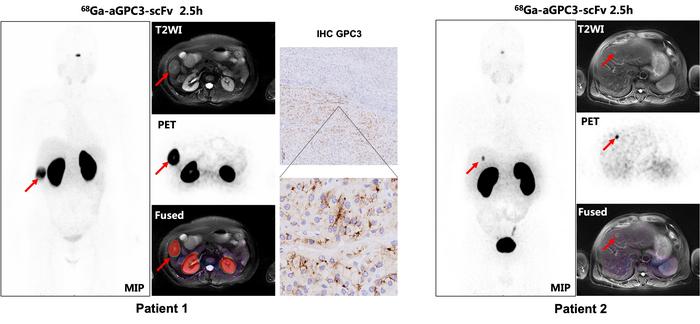A groundbreaking development in the early detection of hepatocellular carcinoma (HCC) has emerged from the halls of Wuhan Union Hospital at Huazhong University of Science and Technology. Researchers have unveiled a novel molecular imaging agent, designated 68Ga-aGPC3-scFv or XH06, capable of precisely targeting glypican-3 (GPC3), a cell surface receptor that is prevalently overexpressed in HCC tumors. This advancement promises to revolutionize the landscape of liver cancer diagnostics, providing clinicians with an unprecedented tool to visualize tumors at their earliest stages with remarkable clarity and specificity.
Hepatocellular carcinoma remains a formidable challenge in oncology due to its aggressive nature and insidious progression. As the sixth most common cancer worldwide and the third leading cause of cancer mortality, HCC’s lethality is underscored by a dismal five-year survival rate hovering at 18 percent. This is largely attributable to the fact that the disease frequently escapes detection until it advances to unmanageable stages. Chronic hepatitis infections and cirrhosis constitute the common milieu for HCC development, complicating early identification efforts due to background liver damage and extensive fibrosis.
Traditional diagnostic modalities for HCC typically rely on contrast-enhanced computed tomography (CT) and magnetic resonance imaging (MRI), which primarily detect anatomical and structural changes within hepatic tissue. However, these techniques often fall short in identifying nascent tumors or small lesions, which can be less than one centimeter in diameter. Herein lies the promise of molecular imaging, specifically positron emission tomography (PET), which delves beyond gross anatomy to reveal molecular and cellular alterations that precede visible manifestations on conventional scans.
The novel agent 68Ga-XH06 capitalizes on this molecular imaging frontier by selectively binding to GPC3 — a proteoglycan linked intricately with tumorigenic pathways in hepatocytes. This selective targeting yields high-contrast PET/MR images that differentiate malignant lesions from surrounding healthy liver tissue with exceptional precision. The pilot clinical study, involving 36 patients with suspected HCC, demonstrated that the tracer is not only highly sensitive but also remarkably specific, with sensitivity reaching 90.63% and specificity achieving 100% when validated against histopathological examination.
Pharmacokinetic analyses and safety profiling underscored the agent’s favorable characteristics. Post-injection, tracer biodistribution was characterized by low non-specific uptake, with the exception of renal clearance pathways that exhibited expected accumulation in the kidneys. Importantly, no adverse effects related to the agent were reported throughout the study, underscoring its safety and tolerability in a clinical setting. This profile is crucial as it opens the door for wider clinical adoption and serial imaging follow-ups.
Of particular interest was XH06’s capability to detect sub-centimeter lesions that often elude conventional imaging. Early detection at this microscopic scale is vital as it enables intervention at a stage when potentially curative therapies remain viable. Visualization of these minute tumors was achieved with impressive tumor-to-liver contrast ratios, a feat that could shift current diagnostic paradigms dramatically. This could ultimately translate into earlier staging, refined treatment planning, and improved patient prognoses.
The imaging agent’s structural design—an antibody fragment labeled with gallium-68—embodies a strategic convergence of immunology and nuclear medicine. The small single-chain variable fragment (scFv) format of the antibody facilitates rapid tissue penetration and faster blood clearance compared to full-sized antibodies, enhancing image quality and reducing background noise. Gallium-68’s positron emission facilitates high-resolution PET imaging, compatible with integrated PET/MR scanners that combine functional and anatomical data streams.
This pilot study’s findings herald a new era for immunoPET in HCC diagnostics, highlighting the fusion of molecular targeting and advanced imaging engineering. According to Dr. Mengting Li, lead investigator and nuclear medicine physician, the approach unleashes the full potential of PET imaging by homing in on a tumor-specific antigen, harmonizing sensitivity with specificity. These advancements signal a departure from prior agents that frequently suffered from low contrast or non-specific binding.
Dr. Xiaoli Lan, chairwoman of Nuclear Medicine at Wuhan Union Hospital, emphasized the clinical implications, noting that earlier detection through GPC3-targeted immunoPET could enable life-saving interventions. Timely diagnosis has long been the Achilles’ heel in managing HCC, with current imaging failing to bridge the gap between early molecular changes and overt anatomic lesions. By providing accurate staging early in the disease continuum, clinicians can tailor therapies more effectively, potentially improving survival rates that have historically lagged.
This molecular imaging breakthrough aligns with the burgeoning field of theranostics, which integrates diagnostic imaging with targeted therapeutic delivery. The precise localization of GPC3-positive lesions opens avenues for radiolabeled therapeutic agents or immunotherapies, fostering a personalized medicine approach. XH06’s success thus represents not only a diagnostic milestone but also a foundational step toward comprehensive molecular oncology in liver cancer.
The research presented at the Society of Nuclear Medicine and Molecular Imaging (SNMMI) 2025 Annual Meeting encapsulates a collaborative triumph incorporating expertise in radiochemistry, immunology, pathology, and clinical nuclear medicine. Continued investigations are anticipated to validate these results in larger cohorts, optimizing dosing protocols and refining tracer kinetics to maximize clinical utility. The quest for earlier, safer, and more accurate liver cancer imaging now has a formidable new contender.
In sum, this study punctuates the vital role of molecularly targeted immunoPET in transforming hepatocellular carcinoma diagnostics. With the devastating global burden of liver cancer poised to rise, innovations such as 68Ga-XH06 are pivotal. They hold promise not only in enhancing detection sensitivity but in re-defining treatment timelines and improving patient outcomes. The era of GPC3-directed molecular imaging beckons as a beacon of hope for millions facing the scourge of liver cancer.
Subject of Research: Early detection of hepatocellular carcinoma using glypican-3-targeted molecular imaging.
Article Title: GPC3-targeted immunoPET allows for early detection of HCC: a pilot clinical study.
Web References:
Link to Abstract
Image Credits: Images created by Mengting Li et al., Union Hospital, Huazhong University of Science and Technology, Wuhan, China.
Keywords: Molecular imaging, Medical imaging, Positron emission tomography, Hepatocellular carcinoma, Glypican-3, ImmunoPET, Early cancer detection.




